Hibiscus plants can brighten your garden every spring and summer with vibrant big flowers. They are seen growing on the ground due to their extensive root system. But will Hibiscus grow in pots?
Hibiscus can be grown both in the ground and in pots. If you keep your hibiscus in a pot, choose the right size pot and make sure the pot has adequate drainage. To care for a potted Hibiscus, use well-drained soil, repot when required and fertilize the plant to maintain nutrient supply.
There is a lot more to understand about a potted Hibiscus. If you want to grow Hibiscus in containers, this article will explain how to pot a Hibiscus plant and care for them.
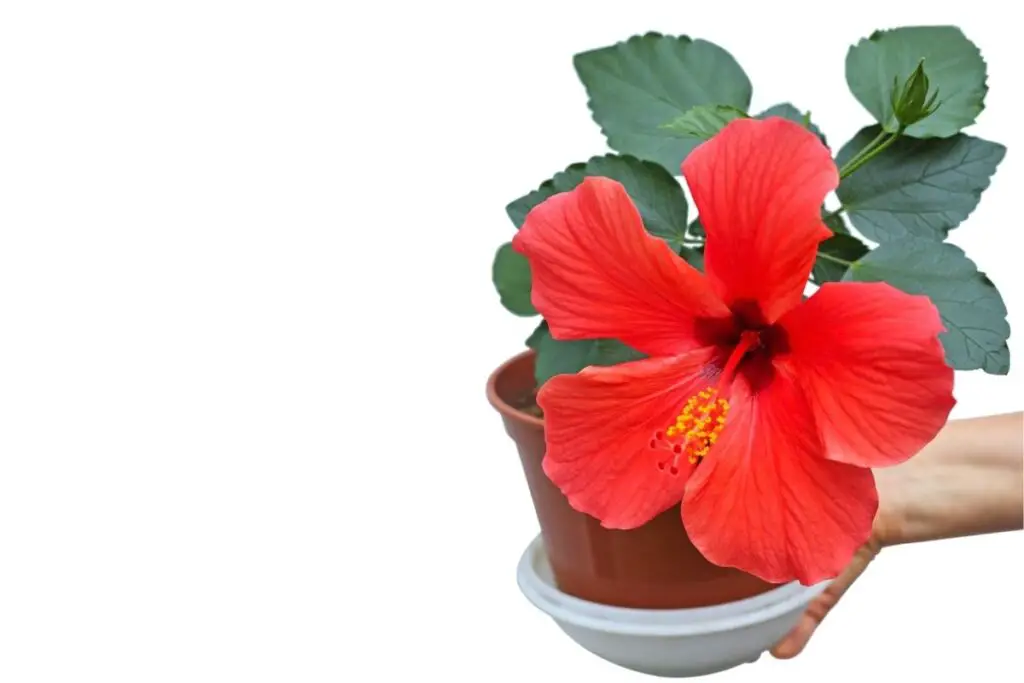
Will Hibiscus grow better in the ground or pot?
Hibiscus will grow well in both grounds and pots.
Since Hibiscus has extensive and 6-inch deep roots, it grows well on the ground.
The roots can spread as much as they need without any limitations.
You don’t have to shift it to another place like the container plants.
But, growing Hibiscus in pots has a lot of advantages.
- It allows the plant to become root-bound, producing more profuse flowers than the plant in the ground.
- When grown in containers, Hibiscus can be shifted from one place to another, from extreme heated sunlight to a shady place or outdoors to indoors in winters.
- In the colder zones, Tropical Hibiscus is grown in containers because this variety cannot tolerate cold weather and requires shifting indoors and staying under a controlled environment throughout the winter.
If your region is expected to have a temperature below 32°F, grow Hibiscus in containers.
Keep them outside in other seasons, but keep them indoors from fall to winter.
So, there is no confirmation as to where Hibiscus plants grow best.
You can grow them as per your zones and wish.
Also read: Where To Keep Hibiscus Plants? (Ideal Spot+Tips)
Can I keep Hibiscus in a small pot forever?
Many gardeners ask this question because they don’t want their plants to grow bigger due to a lack of space.
If your potted plant is outdoors in an open area, you don’t have to use small pots forever.
But, if your planting sight or your indoor space is congested, you have to keep the Hibiscus in a small pot throughout the year.
Hibiscus can be grown in small pots forever due to the space limit in greenhouses with the other plants.
Also read: Should Hibiscus Be Root Bound? (+When To Repot)
What kind of pot is best for the Hibiscus plant?
While using a container for Hibiscus plants, three things require consideration:
- Drainage
- Size
- Material
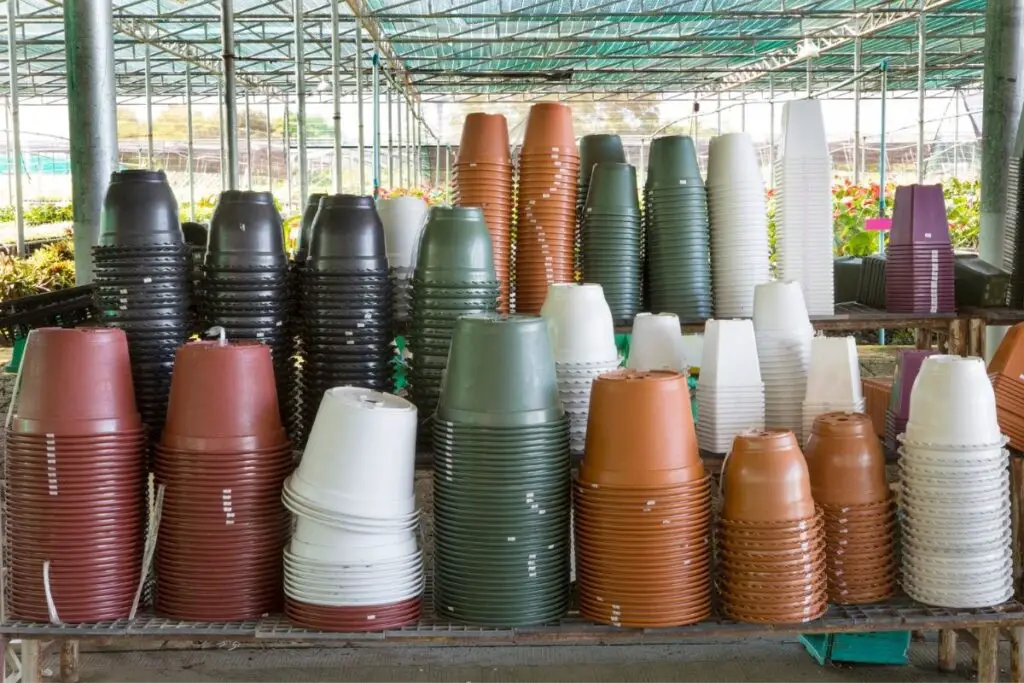
Drainage
The pot you select for your Hibiscus plant should have drainage holes.
Otherwise, the excess water will not be able to drain out.
It will block the oxygen and proper airflow.
The excess water will remain in the soil, suffocate the roots and result in overwatering and root rot.
Suffocated roots fail to pass the water and nutrients to other plant parts and show signs of underwatering and under-fertilization.
It also prevents the flushing of the accumulated salts in the soil.
So, ensure the drainage system in whatever container you choose for Hibiscus.
Size
Size is another important factor.
It has to be proportionate to the plant’s size.
A bigger container requires lots of soil which takes forever to dry.
On the contrary, a small container holds less amount of soil.
Less soil will hold less water and nutrients, which won’t be enough for a big plant.
Besides, the roots don’t get space to spread, causing root-bound.
If you don’t want your plant to grow bigger, you can use the same container size for years.
Hibiscus plants have extensive roots and are not much deep.
The roots are 6 inches deep. When choosing the container, select a wide container.
The depth should be 4-6 inches.
A 10-inch pot is convenient for all Hibiscus plants.
It is easy to handle.
Hibiscus will remain in good shape in this size of the pot.
If you want to keep your plant small in small pots, this size is perfect.
Looking for gardening supplies? We have tested 100's of products before recommending them to you guys. Check out our best pick below:
| Image | Gardening Supplies | Best Price? |
|---|---|---|
 Top
Top Top
Top | Raised Garden Bed Kit | Check On Amazon |
 | XLUX Soil Moisture Meter, Plant Water Monitor, Soil Hygrometer Sensor for Gardening, Farming, Indoor and Outdoor Plants, No Batteries Required | No Results |
 Top
Top Top
Top | 82 Pcs Garden Tools Set and Extra Succulent Tools Set | Check On Amazon |
 | Joeys Garden Expandable Garden Hose with 8 Function Hose Nozzle, Lightweight Anti-Kink Flexible Garden Hoses, Extra Strength Fabric with Double Latex Core, (50 FT, Black) | No Results |
 Top
Top Top
Top | Dual Chamber Compost Tumbler | Check On Amazon |
 Top
Top Top
Top | Sunnyglade Plant Stakes | Check On Amazon |
 Top
Top Top
Top | Organic Cold Pressed Neem Seed Oil | Check On Amazon |
 Top
Top Top
Top | Mighty Mint Gallon :-Insect and Pest Control Peppermint Oil | Check On Amazon |
 Top
Top Top
Top | Scotts DiseaseEx Lawn Fungicide | Check On Amazon |
 Top
Top Top
Top | Jacks Classic 20-20-20 All Purpose Fertilizer | Check On Amazon |
 Top
Top Top
Top | 30,000 Seeds Pollinator Attracting Wildflower Mixture | Check On Amazon |
 Top
Top Top
Top | Survival Vegetable Seeds Garden Kit-Over 16,000 Seeds | Check On Amazon |
Material
A wide range of materials is available – terracotta, ceramic glazed, plastics, wooden, metal, fiberglass, etc.
It would be best to use the right type for outdoor Hibiscus, especially considering the summer season.
Terracottas are the best fit for outdoor Hibiscus plants.
Since they are made of porous materials, it releases hot air.
You can also use plastic pots. It helps to retain moisture a little longer.
It is good for Hibiscus because the plant likes consistent soil moisture.
Avoid using black plastic containers because black color absorbs heat and overheats the roots.
Besides, it becomes brittle and dull over time due to a long stay under the sunlight.
You can also use wooden planters.
They are also porous pots and help release hot air from the plant and the roots.
Avoid using metal pots because they will heat up faster under the sunlight and overheat the roots, causing bud drops.
Metal pots will also develop rust over time.
How to pot a Hibiscus plant?

When you bring a new Hibiscus plant home, it stays in a standard pot with standard soil.
You will have to repot it to a new container with new soil for a healthy growing plant.
Hibiscus can grow large fast, so you must choose a sturdy planter to hold the plant’s weight, such as clay or ceramic containers.
The taller Hibiscus will grow around 5-6 feet while the smaller will grow 2-5 feet.
Choose a container 1-2 inches bigger than the nursery pot.
The pot needs to have drainage holes to drain out the excess water.
Sometimes, soil can seep out through the drainage holes.
Place a coffee filter over the holes before adding soil into it to avoid this.
Make sure that the water drains out well after placing the coffee filter.
To pot the Hibiscus plant:
- Take a pot and fill half of it with the ideal soil mix well in drainage, retention, and fertility.
- Make a hole at the center and place the plant in it.
- The roots should fit well in the container.
- Now, cover the roots and the plant base with the remaining soil. Press the sides well, but don’t tap too much.
- Don’t start immediate watering as the plant may get hurt during this repotting process. So, let it heal for 2-3 days, and then water the plant well.
- Keep them under indirect sunlight for some days until you see new growth. After that, move them to the direct sunlight. Acclimatize while shifting.
How do I keep a potted Hibiscus plant healthy?
A lot of things require consideration to keep a potted plant.
Choose a variety
Though any Hibiscus can be grown in the container, Tropical varieties are the best choice.
Consider certain things:
- Some Hibiscus can overgrow the containers faster than others.
- Some Hibiscus plants are susceptible to changes in the soil pH levels.
- Few are less tolerant of overwatering.
To skip these insecurities, ask the owner about the type of Hibiscus with a high success rate of growing in pots.
Sunlight and location
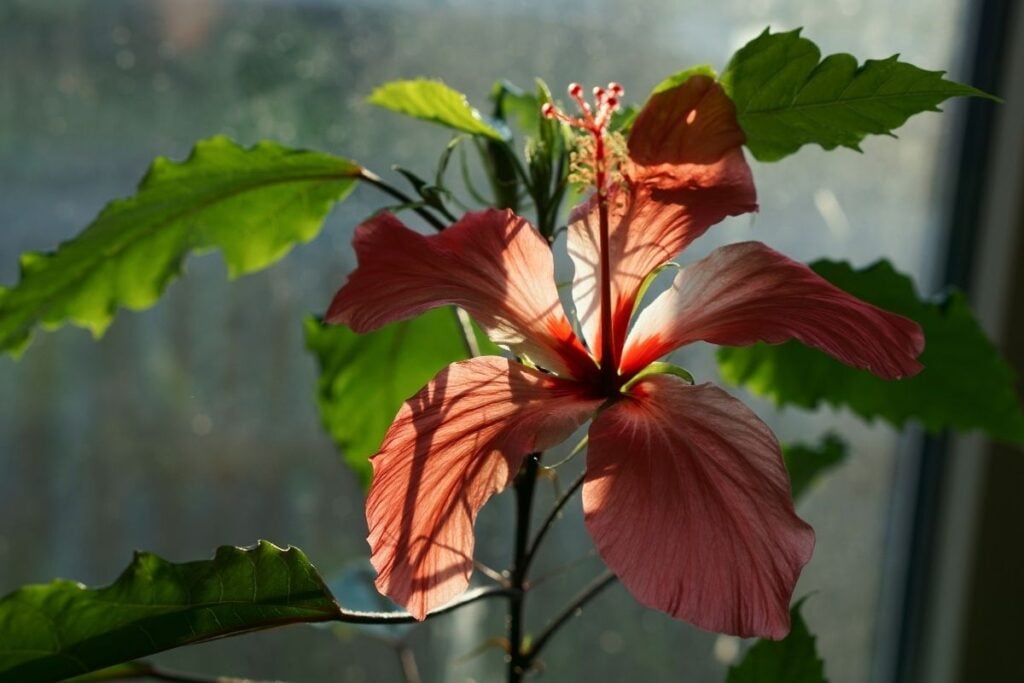
Keep your potted Hibiscus at a location that receives 6 to 8 hours of sunlight.
If the location receives excessive heated sun, shift your plant under partial shade.
Find a location that gets early morning and late day sun and partial shade in the afternoon when solar heat is at its peak, i.e., from 12:00 to 4:00 pm.
Also read: How Much Light Does A Hibiscus Plant Need? (What Kind, How Much & More)
Watering
When you use a pot for outdoor Hibiscus plants, they will require water more often than the grounded plants.
Using terracotta pots helps drainage and releases hot air, but it needs more water.
Due to their porosity quality, terracottas tend to wick away moisture faster than ceramic and plastic pots.
Besides, the pores that help release hot air are also the entry path of heated air.
It results in overheated roots.
So, you have to water them daily if they are under the direct sunlight and the weather is sweltering.
Half of the water drains out of the drainage holes in the pots.
The soil amount in the container is limited.
The soil amount will hold a limited amount of water, which might not be enough for your plant.
For these reasons, provide them 2-3 times watering per day to keep the roots always hydrated and cool.
Also read: How To Water Hibiscus Plant? (How Much, How Often & More)
The potting medium
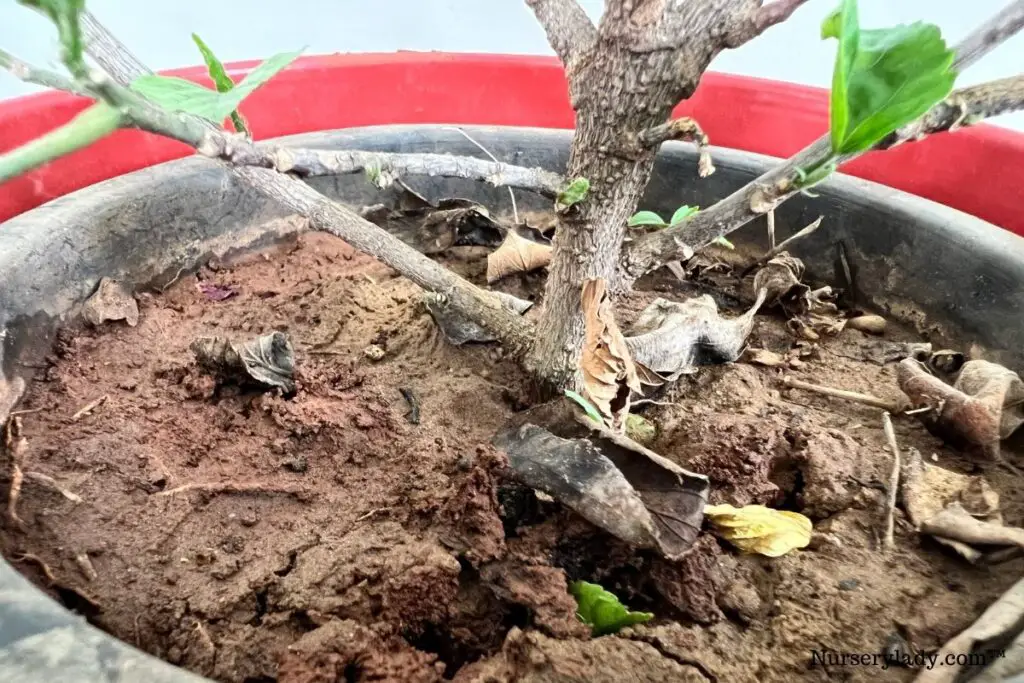
We need to mix 3-4 ingredients in the pots to make it an ideal soil mix for the Hibiscus plant.
It should be good for drainage, retention, and nutrition.
A good soil mix would be coco coir, peat moss, and composted bark for holding moisture and nutrients, along with sand or perlite for drainage.
You can also add organic matters like worm castings or full composted organic matter for microbial life benefits in the pot.
Some suitable soil mixes for Hibiscus plants are:
- 2 parts potting soil, 2 parts peat moss, and 1 part vermiculite or perlite
- 1/3 potting soil, 1/3 compost or worm castings, and 1/3 peat moss or coco coir
- Equal parts of composted bark, composted manure, and coarse peat, with little vermiculite
- 50% peat, 45% composted bark, and 5% perlite
- 2 parts garden soil, 1 part compost, and 1 part sand
Also read: What Kind Of Soil Does A Hibiscus Plant Like? (+Best Soil Mix)
Nutrition
While growing Hibiscus in less than perfect situations, you should increase nutrition supply for growth provocation and stress reduction.
Remember that whatever you provide to your plant will remain in the soil for a long time.
So, be careful while applying anything.
Start with light and frequent fertilization having all essential nutrients.
Use a fertilizer that goes average in nitrogen, low in phosphorus, and high in potassium.
For example, use a fertilizer with an NPK value of 9-3-13, 10-4-12, or 17-5-24.
Also, check the presence of iron and magnesium to support growth and flowering.
Apply a weaker dose by using ½ than the recommended amount.
Once the plant is established, go for a little higher dose and begin weekly fertilization.
You can use a Growth Enhancer to boost your plant.
Loaded with hormones, different types of nutrition, and anti-stress proteins, a Growth Enhancer can help the plant’s overall development.
Also read: What Is A Good Fertilizer For Hibiscus Plants? (Ideal Ratio+Best Pick)
Pruning
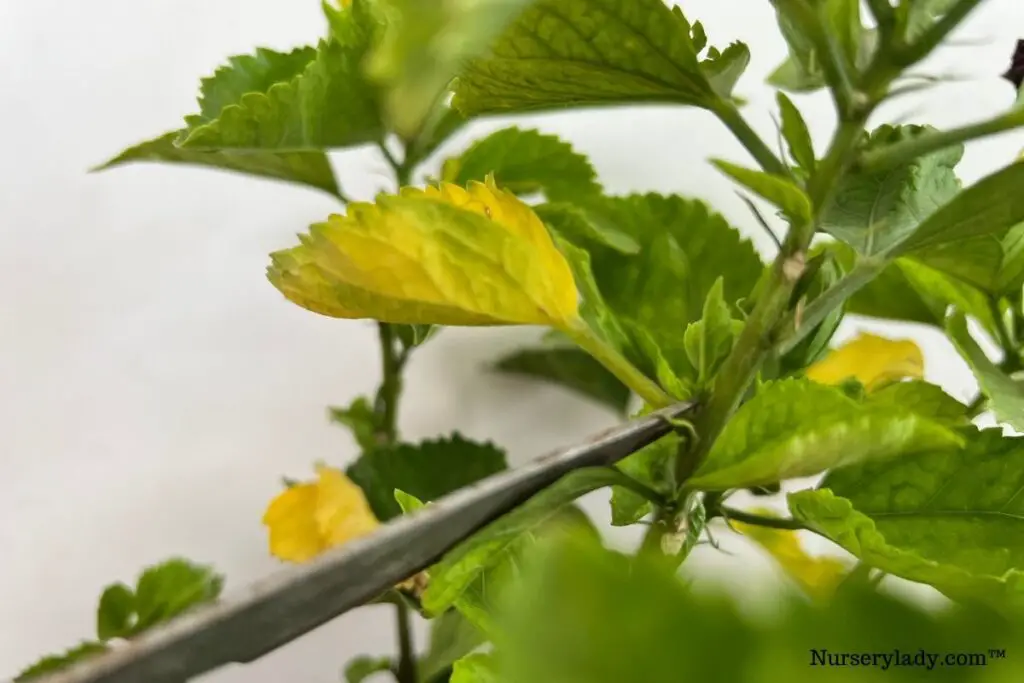
If you want to use a small pot for the entire year or keep your Hibiscus in good shape, pruning is essential.
You have to maintain its shape in a small container because Hibiscus plants are fast growers and can grow big enough.
Decide which direction you want your plant’s branches to grow, and then prune.
If you want your plant to remain full at the top, find a node on the top side of the brach and cut 1/4th inch above the node.
Watch the nodes to understand which direction a branch can grow from a particular node.
It will help you keep your plant in shape.
Then, select a node that can grow branches or flowers in the direction you want it to be and cut above the node.
Even if you change the container every year and allow your plant to grow big, consider slight pruning to fit the plant in the pot.
Also read: How To Prune Hibiscus? (A Step-By-Step Guide)
Root pruning
Since the roots are extensive, the plant will grow wider over time.
The more roots the plant will have, the wider it will become.
Pruning the roots will not let the plant grow much and thus, maintain the plant’s shape in the container.
It also helps in saving a root-bound.
- Remove the plant out and detangle the circled roots.
- Take a sharp, disinfected knife and cut the bottom 2 inches of the root ball. Remove 2 inches of the old soil from the bottom and add fresh soil mix. It will give the plant fresh nutrients.
- Now, place the plant back in the same pot and cover the plant base with the remaining soil.
- Only prune the thin, long, and damaged roots if you want your plant to grow big.
- As the roots receive fresh, new soil, the plant will receive the growth hormones and develop more branches at the top.
Repot
Repot your potted Hibiscus plants every year.
Since they are fast-growing plants, they will often require repotting for more space and nutrients.
For repotting:
- Take the plant out of the old pot.
- Remove the dead and damaged leaves and dead, long and thin roots.
- Add new soil to the new pot.
- Plant your Hibiscus in it.
- Water after 2-3 days.
- Wait for some weeks or a month to fertilize.
- Choose a pot 1-2 inches bigger than the old one and use new soil restocked with nutrients.
- If you don’t want your plant to grow bigger, use the same old pot but fresh soil to give the plant fresh nutrients. Consider root pruning for shape maintenance.
Temperature
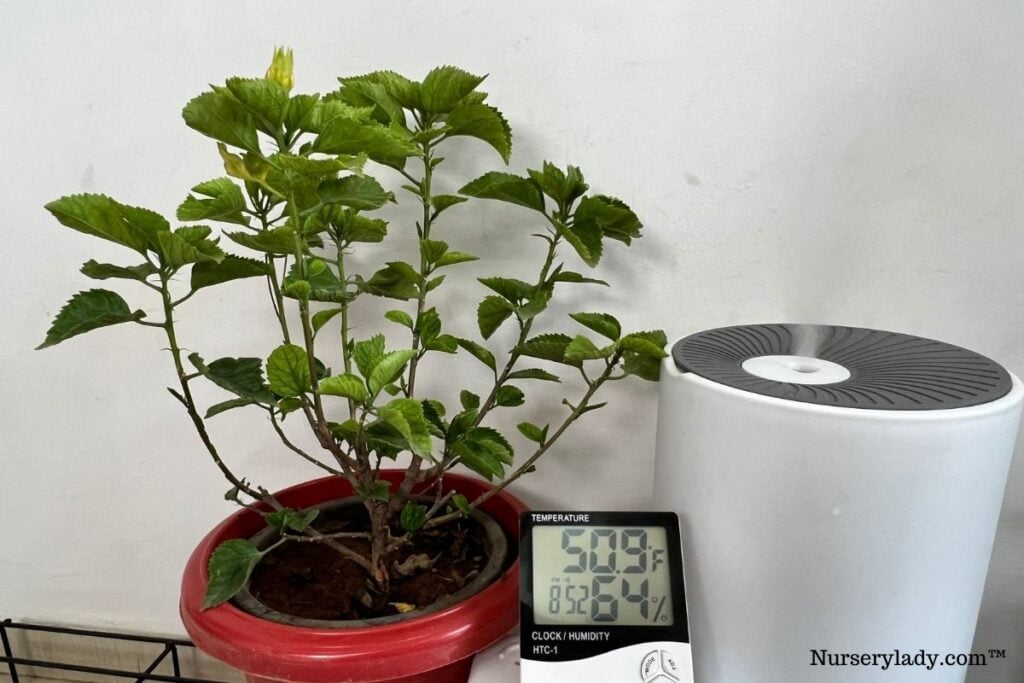
Hibiscus requires a temperature ranging between 65 and 75°F.
If the weather is too hot, shift your plant to a somewhat shady location.
Tropical Hibiscus requires growing in pots if you live in more temperate or colder zones. It requires overwintering by taken indoors.
Also read: Hibiscus Temperature Tolerance: Ideal Range+USDA Zones
Humidity
The outdoor plant will get the same humidity as in nature.
Keep pebble trays under the potted plant if you wish to increase it.
You can also keep some tropical plants close to each other or create levels with other plants.
It is easier with potted plants.
Also read: Do Hibiscus Like To Be Misted? (+Humidity Requirements)
Pests and diseases
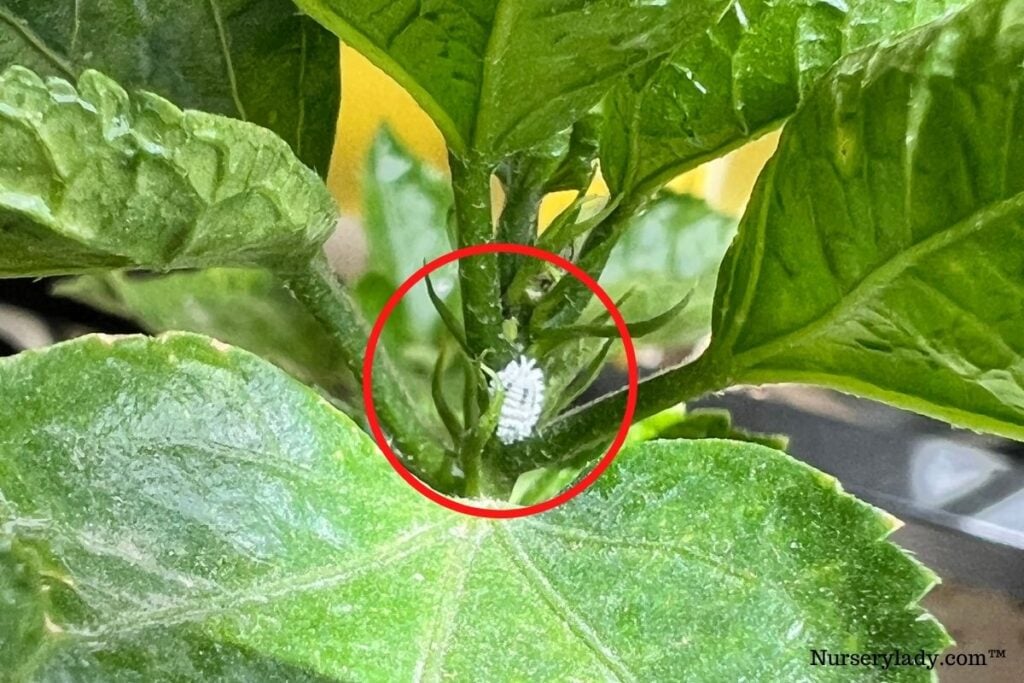
Watch out for pests and diseases.
The common Hibiscus bugs are aphids, spider mites, thrips, mealybugs, scales, caterpillars, and beetles.
Take immediate actions by using neem oil, insecticidal soaps, rubbing alcohol, Imidacloprid, and natural predators like lacewings and ladybugs.
To treat diseases, remove the damaged parts, isolate the plant, and spray fungicide.
Avoid overwatering as prolonged dampness is the cause of many diseases, including root rot.
A potted plant has higher root rot chances than a grounded plant.
Also read: How Do I Get Rid Of Bugs On My Hibiscus? (Common Bugs+Fix)
Final words
Hibiscus plants will grow great in containers provided you follow the certain required care tips like pot size, repotting, pruning, etc.
Choose the right container size, repot every year, and prune the plant. Pruning the plant and the roots keep the plant in shape and match well with the pot. Pruning is needed more if you don’t want your plant to grow big or use the same small container.
- Give them correct watering, sunlight, and fertilizer.
- Use the recommended soil mixes for better results.
- Maintain ideal temperature and humidity.
- Growing Hibiscus in containers is beneficial, like easy shifting and profuse blooming due to root-bound.
Reference: Wikipedia, ASPCA, Louisiana State University Agricultural Center, American Society for Horticultural Science, Tropical Hibiscus by Texas A&M University, Sciencedirect.
